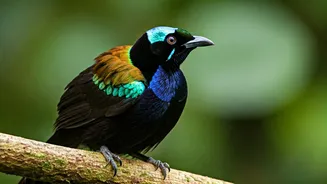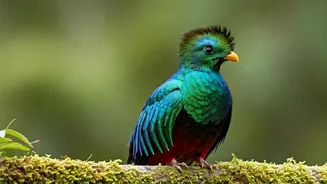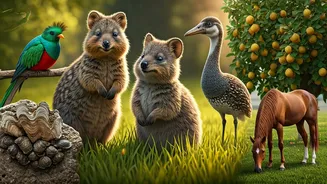Scarlet Macaw
The Scarlet Macaw is undeniably one of the most stunning birds on Earth, instantly recognizable for its brilliant plumage. Native to the tropical rainforests
of Central and South America, these large parrots are a vibrant mix of scarlet red, with accents of yellow and blue on their wings. Their bold colors serve as a form of communication, social signaling, and even camouflage within their environment. Beyond their striking appearance, Scarlet Macaws are known for their strong pair bonds, often staying together for life. They are intelligent and social birds, and play a vital role in their ecosystems, especially in seed dispersal. Sadly, habitat loss and the pet trade have put their populations at risk, making conservation efforts all the more important.
Indian Peafowl
The male Indian Peafowl, more famously known as the peacock, presents an unmistakable display of color. The peacock's train, a collection of elongated upper tail covert feathers, is a sight to behold. These feathers feature iridescent blues, greens, golds, and other colors, with eye-like ocelli, making them a focal point during courtship displays. Peafowls are native to the Indian subcontinent, and their magnificent trains are used primarily to attract peahens during mating season. The vibrant plumage is a visual signal of their fitness and health. Beyond their aesthetic appeal, peafowls also play a significant role in their environment by controlling insect populations. They are often associated with good luck and prosperity in many cultures.
Mandarin Duck
The Mandarin Duck, found in East Asia, is renowned for its intricate and vibrant plumage. The male Mandarin duck, or drake, is a showstopper, sporting a striking combination of colors and patterns. It has a chestnut face, a long orange 'sail' on its back, a white stripe above its eye, and iridescent purple feathers on its chest. The drake's plumage is most prominent during the breeding season when the colors are at their most vibrant. Mandarin Ducks are often associated with love, fidelity, and happiness in Eastern cultures. They are typically found in forested areas near ponds and lakes, where they feed on seeds, insects, and other aquatic life. Their distinctive appearance makes them a popular subject of art and admiration.
Rainbow Lorikeet
The Rainbow Lorikeet, a native of Australia and parts of the surrounding islands, truly lives up to its name. These parrots display a vibrant medley of colors, from the bright blue of their heads and bellies to the vivid green of their backs and wings, and the flashes of orange and red on their breasts. These colors make them highly visible in their natural habitat. Rainbow Lorikeets are known for their playful personalities and social behavior, often seen in large flocks. They have specialized tongues that are adapted for feeding on nectar, pollen, and fruit, and play a crucial role in pollinating certain plants. Their colorful presence is a well-loved part of the Australian landscape.
Atlantic Puffin
The Atlantic Puffin, a charismatic seabird, is instantly recognizable due to its brightly colored beak, especially during the breeding season. Its beak is a mosaic of red, yellow, and blue, contrasting sharply with its black and white plumage. Puffins primarily live on islands and coastal areas in the North Atlantic. They spend most of their lives at sea, only coming ashore to breed. Their colorful beaks are used in courtship displays. Puffins are adapted to dive deep underwater to catch fish. The Atlantic Puffin's unique look has made it a popular icon, though like many seabirds, their populations are threatened by climate change and overfishing.
Blue Jay
The Blue Jay, found in North America, is a familiar sight with its vibrant blue, black, and white plumage. The blue coloration is not due to blue pigments but rather structural coloration, a result of the way light reflects off the feather structure. Blue Jays also have black markings on their wings, tail, and head, with white accents. They're intelligent birds with complex social behaviors, capable of mimicking sounds and communicating with each other. They play an important role in forest ecosystems, helping to disperse seeds and bury acorns for later use. Blue Jays are adaptable and can be found in various habitats, from forests and parks to suburban gardens.
Resplendent Quetzal
The Resplendent Quetzal is a magnificent bird, revered in Mesoamerican cultures for its beautiful appearance and symbolic importance. Native to the cloud forests of Central America, the male Quetzal features iridescent green plumage, a red breast, and long tail feathers that can reach up to a meter in length. These elongated tail feathers are particularly striking during the breeding season. The quetzal is considered sacred in many cultures, symbolizing freedom and wealth. This bird plays a significant role in its ecosystem by dispersing seeds. Their vulnerable status underscores the need for continued conservation efforts to protect their forest habitat and ensure their survival.
European Bee-eater
The European Bee-eater is a vibrant bird found across Europe, Asia, and Africa. Their plumage boasts a stunning array of colors. Their appearance includes a combination of green, blue, yellow, and brown tones, often with a striking black eye stripe and a long, slightly curved beak. As the name suggests, Bee-eaters are known for their diet of insects, especially bees and wasps. They catch insects in mid-air, a skill they use to their advantage. They are gregarious birds, often seen in flocks, particularly during the breeding season. Their vibrant colors and aerial acrobatics make them a favorite of bird watchers.
















